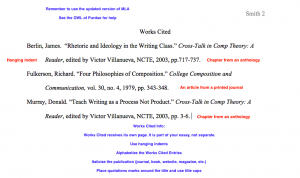
#MLA MANUSCRIPT FORMAT FULL#
Write your full name, first and last (and middle initial, if you like). It is presented near the bottom of the page, above the rest of the details.

Place your name about 4-7 lines below your title. In the example below, note that the main title is a quote from the book:Īnalyzing Dorothea’s Changing Desires in George Eliot’s Middlemarch. In this case, the title is followed by a subtitle, written directly below it. However, these might not provide sufficient information about the paper. Similarly, if your title contains the name of a body of work or text, that part needs to be in italics.Īdding a witty title to your paper instantly improves engagement. However, if your title contains quotes, then only that part needs to be inside double quotes. There is no need to add quotation marks around the title. It should not be bold, italicized, or underlined. The title uses the same font and font size as the rest of the paper. The first letter of each word is capitalized, barring the small words, which are usually articles (a, an, the) and short prepositions (of, on, in, to, etc.). Ideally, the title should be short and crisp – it should directly address the topic and concern of the paper. It is placed around the middle of the page, about one-third of the way below the university name. This is the key element of the title page. If your affiliation is not with a traditional university/academic institution, you can simply write the organization where the following document is going to be submitted or the organization that the document represents.

If the university name isn’t available, you can leave it out because this is an optional element (unless instructed otherwise). The university name is mentioned at the top of the title page. The following details are presented on a title page, mentioned in order from top to bottom: Center-aligned text on the title page (the rest of the paper is left aligned).Your last name along with the page numbers on the top right corner (Running head).The title page will follow much of the same paper formatting rules that the rest of the paper follows. MLA title page formatĪlthough the MLA system does not have a set format for creating title pages, there are certain basic rules and format settings that you can use to create a title page.


#MLA MANUSCRIPT FORMAT HOW TO#
An MLA heading appears on the same page on which the main paper copy starts, the heading is aligned to the left, and it only appears at the top of the page.įor more information on how to create headings, refer to the MLA heading guide. A title page is on its own page before the main paper copy, centers the text, and spreads the text throughout the title page. The main difference between a title page and an MLA heading is where and how it is formatted. Both also come before the main paper copy. The MLA heading appears at the top of the first page of an MLA formatted paper and contains similar information to a title page: your name, instructor’s name, class or course name, and date. You should not confuse an MLA title page with the MLA heading. You only create one if your instructor or institution requests a title page and specifies the format requirements.įor help writing your essay, research paper, or other project, check out these writing tips. This means that in most cases, you will not create an MLA title page. In that sense, a title page sets the stage for your writing and is related to the overall presentation of your paper.Ī title page is not a compulsory element of the MLA system and is only added when specifically required. It provides the most basic details about your assignments, especially those which aid in identification. A title page, or cover page, is like a book cover for your assignment.


 0 kommentar(er)
0 kommentar(er)
